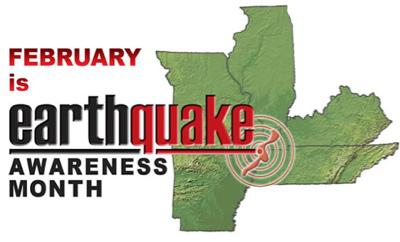
Submitted by
Dee Loflin, SMT Manager/Writer
Missouri - This February will mark the 202nd anniversary of one of the largest earthquakes ever recorded in the continental United States, which was centered in the southeast Missouri town of New Madrid. The Feb. 7, 1812 earthquake is a key reason Missouri observes Earthquake Awareness Month each February and encourages residents to think about earthquake safety.
“Missouri experiences a wide range of natural disasters, from ice storms and blizzards to tornadoes and flooding, but an earthquake provides no warning and a major quake would have a large and long-term impact on our state,” said State Emergency Management Agency Director Michael Barrett. “Earthquake Awareness Month is an excellent opportunity to learn about and prepare for a potential earthquake and many of the safety steps apply to other emergencies as well.”
On Oct. 17, 2013, more than 406, 000 Missourians participated in the Great Central U.S. ShakeOut earthquake drill, which teaches participants to "Drop, Cover, and Hold On” – drop to the floor, cover under a desk or table and hold on in the event of an earthquake. But there are other simple steps that people can take, particularly those who live in or near the New Madrid Seismic Zone.
· Put together an emergency kit, including a flash-light, first aid kit, radio, drinking water and blankets.
· Develop a family communication plan. Identify a relative living at least 100 miles away; everyone can call to “check in” to tell family you’re safe.
· Bolt bookcases to wall studs, install strong latches on cupboards and strap the water heater to wall studs—if it tips over it could start a fire or gas leak, and you could lose a valuable source of water.
· Know how to turn off your gas and water mains.
· Understand that earthquake coverage is not included in most homeowner insurance policies. It must be purchased as separate coverage, called an “endorsement.” This type of insurance requires that the earthquake is the direct cause of damage to the property. The Missouri Department of Insurance has more: http://insurance.mo.gov/consumers/home/EQTable.php
Missouri is home to the New Madrid Seismic Zone, centered in southeast Missouri and the nation's most active earthquake zone east of the Rocky Mountains. At least three of the largest earthquakes ever recorded in the continental United States are believed to have occurred in that area in 1811-12 – the largest of which occurred on Feb. 7, 1812.
Events scheduled during Earthquake Awareness Month include:
· Feb. 4 – The Missouri Seismic Safety Commission holds its quarterly meeting in Jefferson City at 10 a.m. in Room 494 of the Truman State Office Building, followed by a reception for the general public on the third floor of the State Capitol at1 p.m.
· Feb. 8 – The St. Louis Science Center will host an earthquake awareness day from 10 a.m. to 3 p.m., offering hands-on activities that teach participants how to prepare homes, families and businesses for earthquakes. The event is free and open to all ages.
· Feb. 22 - “The Earth Moves Under Our Feet” program from 10:30 a.m. to noon at Onondaga Cave State Park near Leasburg. Representatives from SEMA and the Missouri Department of Natural Resources' Missouri Geological Survey will present a program about earthquake history, preparedness, and impacts on society. A video about earthquakes in the Midwest will be shown. Admission is free. Onondaga Cave State Park is located seven miles southeast of the Leasburg exit off of Interstate 44 on Highway H.
SEMA has information about earthquake safety and resources, including videos, to help citizens prepare for an earthquake. Check out SEMA's Earthquake Preparedness Web page: http://sema.dps.mo.gov/earthquake_preparedness/ .
In Missouri, a major New Madrid Seismic Zone earthquake would likely be felt throughout the state, as well as in nearby states to the south and east. Missouri has a comprehensive earthquake response plan in place to assist the 47 counties that likely would be impacted most directly. Visit the Department of Natural Resources’ website for information about the science and history of earthquakes in the state at: http://dnr.mo.gov/geology/geosrv/earthquakes.htm.

